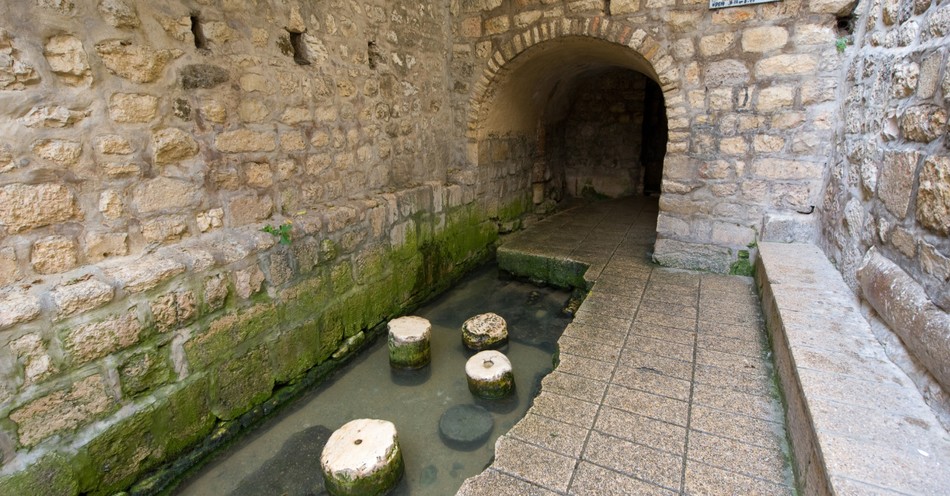The Pool of Siloam in the Bible is the setting for Jesus' healing of the blind man. As with any great story, the setting has important meaning for the event, and Jesus often said or did things where the specific place added extra significance. God does nothing randomly. His intentionality fulfills his promises, and his eternal word embeds meaning into the event, the people’s names, and the place where they occurred.
For the Jewish readers of the New Testament, many would have understood these embedded meanings without needing them to be explained. But for us two thousand years later in a vastly different time, language, and culture, we must explore a bit to discover what God was saying through a miracle at the Pool of Siloam and what it means for us today.
Where is the Pool of Siloam Mentioned in the Bible?
The name Siloam appears in the Old and New Testaments. In Hebrew, Siloam comes from the word Shiloach, meaning “sent” or “sending forth.” The New Testament Greek word is Siloam, as we read in English in the Gospel of John, and it also means “sent.”
In John 9, Jesus and his disciples walked by a man who had been born blind. The disciples asked if the man’s blindness was caused by sin. Jesus explained that the man’s disability wasn’t due to sin, but so God’s power could be revealed. Jesus spit on the ground, made mud, and applied it to the man’s eyes. Jesus instructed the man, “Go, wash in the Pool of Siloam.” The man obeyed, and upon washing in the pool, the Lord restored his sight. The man returns to Jesus, able to see.
In the Old Testament, 2 Kings 20 and 2 Chronicles 32 indirectly reference the Pool of Siloam. The pool was part of a larger water system designed by the righteous King Hezekiah to protect Jerusalem’s water supply from the Assyrians.
Isaiah 8:6, the Pool of Siloam, referred to as the “waters of Shiloah,” plays a more symbolic role in Isaiah’s message to the Judah’s people. The prophet Isaiah lived at the same time as Hezekiah. Isaiah 8 contrasts the peaceful waters of Siloam with the destructive force of the Euphrates River, the sign of the Assyrian army. The Pool of Siloam represented God’s provision and protection over Jerusalem. The waters became a source of life during a difficult time, representing God’s peaceful care for Judah.
However, in Isaiah 8, the prophet accuses the people of rejecting these waters. Instead of relying on God, they sought alliances with foreign nations, turning away from the Lord. Israel warns that because they lacked faith and trust in God, they would face the force of the Assyrians, symbolized by the Euphrates’ floodwaters.
What was the Purpose of the Pool of Siloam?
During Hezekiah’s reign, the city faced the threat of Assyrian invasion, and the city needed access to water for its survival. Hezekiah built a tunnel and water system to redirect water from the Gihon Spring, located outside the city walls, and into the Pool of Siloam, inside the city’s defenses. This construction gave Jerusalem water during times of siege. The pool provided water for the people during times of crisis. The water system, which included the 533 meters of Hezekiah’s Tunnel, remains a remarkable achievement of ancient Jerusalem.
Beyond the practical use, the Pool of Siloam carried religious significance, particularly during Jewish festivals like the Feast of Tabernacles. During the feast, a unique water-drawing ritual took place, rooted in biblical tradition and (not surprisingly) messianic symbolism. The Feast of Tabernacles (Leviticus 23) joyfully celebrated the Jewish ancestors’ wandering in the wilderness and God’s provision for them, including water. In the wilderness, God miraculously provided water from a rock more than once.
Each day of the Feast of Tabernacles, priests would draw water from the Pool of Siloam, carry it in a pitcher to the Temple, and pour it on the altar as part of the sacrifice. This ritual symbolized God’s provision of water in the desert and included prayers for future rains and blessings.
How Did Jesus Use the Pool of Siloam in His Ministry?
In Jesus’ time, based on the blessings and curses of the Old Testament, Jews assumed someone experienced blindness or some other infirmity as a result of sin and disobedience. Even the parents’ sins could be passed down to the children, at least in the Mosaic Law. So when the disciples encountered the man born blind in John 9, they asked what they considered a theological question. "Who sinned, the man or his parents?" they questioned Jesus, assuming it had to be one of the two.
Jesus took this opportunity to give a third answer. Jesus often did this when answering questions, especially when Pharisees or scribes tried to catch him in a trap. For instance, they once asked Christ, “Should we pay taxes to Caesar?” They hoped for a yes or no to criticize him one way or another as a religious heretic or rebel against Rome. Instead, Jesus gives a third option. He asked for a coin, pointed to the image of Caesar, and gave the answer, “Give what is Caesar’s to him.”
Here, similarly, Jesus uses the moment to dismiss the Jewish theological assumption, and he says, “Neither this man nor his parents sinned, but this happened so that the works of God might be displayed in him.” Jesus teaches how sometimes God allows brokenness to end up revealing his glory and power. All of us deal with sin and hardship in our lives. Sometimes we receive consequences due to our sin, other times we deal with the normal corruption in the world through natural disasters or disabilities.
To further illustrate the point, Jesus spits in the ground, makes mud, and puts it on the man’s eye. This was a fairly unclean act, according to Jews. And it happened to the man; he bore no responsibility for the mud in his eye. Then Jesus instructs the man to go and wash in the Pool of Siloam, which means sent. Through his obedience, the man is healed.
First, Isaiah used the pool to symbolize trust in God’s provision and life, also confirmed through the traditions during the Feast of Tabernacles. The metaphor for God’s provision, saving people from death, is both past, present, and future. The blind man washed, a type of baptism, in those infamous waters, representing how in times of distress, believers must seek out God’s provision over all others.
In addition, Siloam means sent. The man’s healing happened when he obeyed the sending. Being sent cleansed him. Christ was sent by the Father to bring healing and salvation to the world. When filled with Christ’s Spirit (the “sent” Spirit), believers are also sent into the world to live and preach the Gospel, to seek and save what was lost. Jesus followers find their own healing and the salvation of others while on mission with God. Miracles happen when Christians walk with Jesus through life and trust his salvation.
At the same time, blindness and sight have deep spiritual meaning. Throughout chapter 9, John contrasts the healing with the spiritual blindness of the Pharisees and religious leaders. Not only is the man’s sight restored, he also gains insight into Jesus’ identity as the Messiah. By the end of the chapter, he proclaims his belief in Jesus as the Son of God, while the priests continue to reject who Jesus really is. Jesus declares himself the light of the world (9:5), revealing his broader mission to bring light to the spiritually blind.
As believers follow Jesus, being sent with him, they know him fully as Lord of their life.
What Does the Pool of Siloam Teach Us About Faith?
First, we must ask the Spirit regarding situations we encounter. We shouldn’t assume, as the disciples did, that we know what’s behind an action or circumstance. God does know, and he will reveal the unseen reality. When we ask God for wisdom, he faithfully provides it (James 1:5). God will show us how to proceed to love and bring life to others. Christ-followers must seek the illumination he offers to know truth, to love and heal others. Otherwise, we are blind guides like the Pharisees and priests.
Second, once we know the spiritual truth behind the situation and God gives us direction, we must obey. There’s power in obedience. Just as the man had to trust that washing in the pool would result in his healing, we must trust God’s instructions and obey. Often, God’s instructions don’t make sense to us or may involve actions that require becoming uncomfortable. Faith and belief include action and obedience. With obedience, God enacts his power. We then trust him with the consequences because it’s his plan.
Finally, walking with Christ on his path increases our understanding of Jesus. The “knowing” of the New Testament means intimate experience, becoming one with something. While reading books and learning theology is fine and good, truly knowing God comes through consistent trusting and obeying him.
Is There Historical Evidence for the Pool of Siloam?
Reading about the biblical significance of the Pool of Siloam may make us wonder whether there is historical evidence for it or if it still exists today. In 2004, an archaeology team discovered the Pool of Siloam in Jerusalem. Workers repairing a sewage pipe near the site accidentally revealed steps leading to what was later confirmed as the pool. Further excavations uncovered a large pool structure with steps descending into it, very similar to the design described in ancient sources. These findings confirmed Jews used the pool for religious rituals and other practical purposes, matching its biblical description. More research indicated the time of construction to be during the time of King Hezekiah as part of the water system connecting the Gihon Spring and Hezekiah’s Tunnel.
Also, ancient Jewish writings and traditions, such as those recorded by Josephus (a first century Jewish historian) and the Mishnah reference the Pool of Siloam as a major place for purification during the Feast of Tabernacles. These references coincide with the archaeological evidence, showing how the pool played an important role in the religious and daily life of Jerusalem as the Bible records.
As archaeology often does, these findings strengthen the credibility of the Bible and its narrative. The Pool of Siloam was a real place with spiritual significance.
Peace.
Further Reading
What Does the Pool of Siloam Teach Us about Healing?
Pool of Siloam Steps, Where Jesus Walked and Healed the Blind Man, are Unearthed
Photo credit: ©Getty Images/Robert Hoetink




